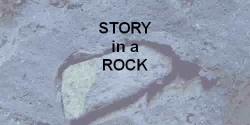Mysterious Killer Mineral
Mysterious Killer Mineral - arsenopyrite and friends
Let the rocks tell their story...
More about arsenic...
Scary
stuff about arsenic as a poison...
Beware Green Wallpaper!
Other killer minerals
include...

The Story
Near Irvinebank in far north Queensland, Australia is a creek known as Poison Creek.
A hidden killer mineral lurks in the rocks under the creek.
To look you would never know!
The creek tends to be fenced off because in the dry season cattle that drink from the pools can die.
How can rocks in a creek kill cattle?
It has a lot to do with the weather.
Due to the extreme weather variations in the area (a short very wet season and a very dry season), a killer mineral weathers quickly and oxidises into the deadly white powder of arsenic trioxide
Evaporation concentrates the poison in the water and around the edges of the pools where it looks like salt to the cattle.
Cattle like licking salt and in this hot dry area or Australia cattle farmers (graziers) even put out blocks of salt for the cattle to lick.
The cattle (and humans as well) are poisoned by a mineral known as Arsenopyrite FeAsS - which is 46% Arsenic by weight.
.
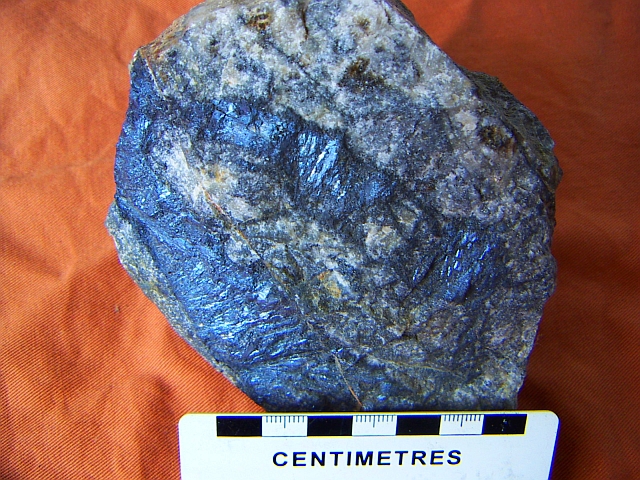 Arsenopyrite is the silvery mineral
Arsenopyrite is the silvery mineralMore about arsenic...
Only about 5% of arsenic consumption is of the metallic element. Most of this is used to alloy (mix) arsenic with lead, copper, or other metals for specific uses. As a metalloid, arsenic is a semiconductor, like silicon. This means it conducts some electricity like a metal, but not all the electricity a true conductor like copper would conduct. Consequently, about 1/10 % of arsenic is consumed in the manufacture of gallium arsenide semiconductors for use in electronics. Some arsenic is also used in glass-making. Most arsenic is in the form of chromated copper arsenate (CCA), a chemical used as a wood preservative for telephone poles, fence posts, pilings, and foundation timbers. The CCA significantly reduces rot and eliminates wood destruction by termites, ants and other insects. However, the use of CCA is being phased and a major decrease in the arsenic market is expected as a result. Formerly the most important use of arsenic compounds, was as an insecticide sprayed in fields and orchards. This use has entirely disappeared in most countries, due to the poisonous nature of arsenic compounds. Arsenic contamination is a problem in some well-water and may be associated with mine drainage.
Scary stuff about arsenic as a poison...
While metallic arsenic can pass through your body unharmed if it oxidises to arsenic trioxide it be comes a deadly poison.
In early-nineteenth-century England, a good way to get rid of your husband was arsenic. A medical examiner usually couldn’t tell whether the poison was involved, because the symptoms—diarrhea, vomiting, abdominal pain—are much like those of other disorders. Nor could he necessarily place you at the murder scene. The dying typically took hours. Also, you could administer the poison gradually, a little bit every day. In the mid-century, arsenic poisoning was commonly the resort of women. (In 1851, the House of Lords tried to pass a law forbidding women to buy arsenic.) But unpleasant husbands were not the only people you might want to eliminate. During this period of feverish social mobility, a young person might be waiting impatiently for an inheritance, and there was Uncle Ted, sitting on all that money and meanwhile bossing you around, toying with your hopes. In such cases, male poisoners presumably outnumbered females.
Through much of the nineteenth century, a third of all criminal cases of poisoning involved arsenic. One reason for its popularity was simply its availability. All you had to do was go into a chemist’s shop and say that you needed to kill rats. A child could practically obtain arsenic. The going price for half an ounce was tuppence.
When the poisoning becomes acute, symptoms may include diarrhea, vomiting, vomiting blood, blood in the urine, cramping muscles, hair loss, stomach pain, and more convulsions. The organs of the body that are usually affected by arsenic poisoning are the lungs, skin, kidneys, and liver.
Beyond treatment, there was another, more fundamental mystery: doctors usually didn’t know whether the condition they were dealing with was arsenic poisoning. The tests for the presence of arsenic sound almost comical. A favorite was to throw a sample of the victim’s stomach contents into the fireplace. If, as it burned, it smelled like garlic, the corpse was thought to contain arsenic.
The first person to come up with a reliable chemical test for arsenic poisoning was an obscure but determined chemist named James Marsh. His procedure, involved feeding sulfuric acid and zinc through an apparatus that combined tubes, rods, stopcocks, nozzles, and a great deal more. Marsh presented his invention in 1836, and won a big prize for it. (With modifications, it was used for a hundred and fifty years.)
Arsenic is now traceable in the body - use it and you will be caught!
Beware Green Wallpaper!
Vivid green wallpaper was the height of fashion for Victorian England. But the wallpaper was deadly as it contained arsenic which oxidised out in the damp conditions and over time poisoned the occupants of the room.
The origins of arsenic in wallpaper can be traced back to 1778 when the Swedish chemist Carl Scheele first used copper arsenite to create a vivid green pigment. The richness of the colour and its superb pigmentation properties made Scheele’s Green (as it came to be known) highly sought after by paint manufacturers and interior decorators.
Brilliantly vivid shades of green were particularly popular among artists and designers of the Pre-Raphaelite and Aesthetic movements (Christopher Dresser, Walter Crane, and E W Godwin among them) and, in turn, green became a very fashionable colour in which to decorate the home or to dress oneself.
Although not all commercially available green paints contained arsenic, many did, including Emerald Green, Paris Green and Schweinfurt Green, as well as the original Scheele’s Green. Before the craze for these colours had even reached Britain, the dangers associated with arsenical paints had been acknowledged in Europe, but these findings were largely ignored by British manufacturers.
Victorians ate vegetables sprayed with arsenic insecticides and meat from animals dipped in arsenic as a fly deterrent. Panic broke out across the nation in 1879, when it was discovered that lickable postage stamps were also coloured with arsenical dyes, but this was nothing compared to the hysteria that erupted at the beginning of the 20th century with the arrival of a whole new scandal: arsenic in beer!
Other killer minerals include...
Asbestos - Mg3Si2O5(OH)4

This silicate mineral grows thin fibers crystals that can easily break off and form dust particles. Despite its usefulness in insulation, fire resistance, and sound absorption, the mineral dust is deadly if inhaled. The fibers can cause lung cancer, mesothelioma, and asbestosis.
Chalcanthite - CuSO4·5HO
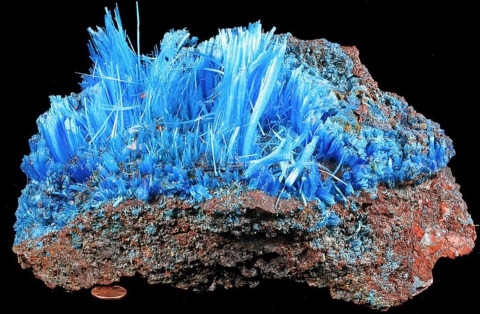
Chalcanthite is a blue coloured hydrated water-soluble copper sulfate. Chalcanthite can easily dissolve and recrystallize in a wet environment which can lead to copper poisoning of an environment. It is toxic to humans and deadly to invertebrates.
Cinnabar - HgS
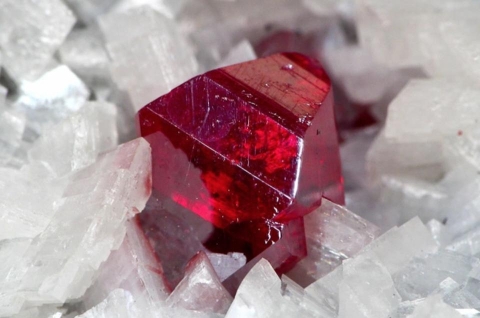
A deep red mercury sulphide mineral that provides much of the world's elemental mercury. Despite the brilliant color and history of use in trading and as a coloring agent, Cinnabar is deadly. Mercury is toxic to humans as it accumulates in the body over time.
Galena - PbS
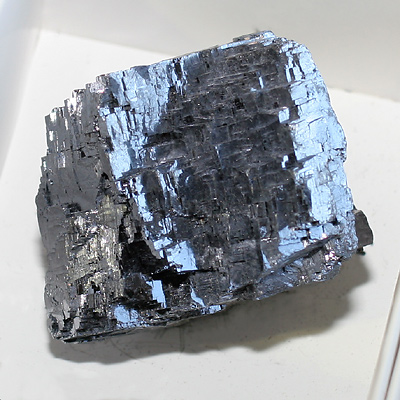
The lead in Galena is toxic to humans if inhaled or ingested from dust particles
Hutchinsonite - (Tl,Pb)2As5S9
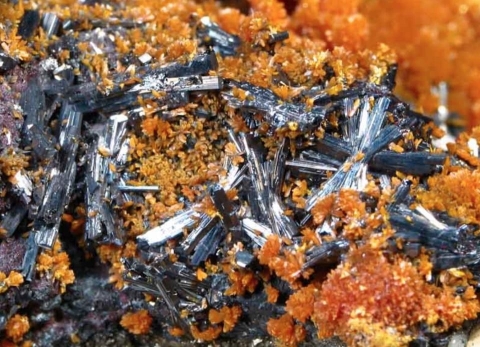
Hutchinsonite is a form of arsenic sulfide with thallium and lead that can be found in hydrothermal vents. Thallium salts are nearly tasteless and highly toxic and have been used in rat poison and insecticides. The thallium inclusion in this arsenic sulfide combines two extremely dangerous and deadly minerals. Exposure to this mineral can potentially lead to death.
Orpiment - As2S3
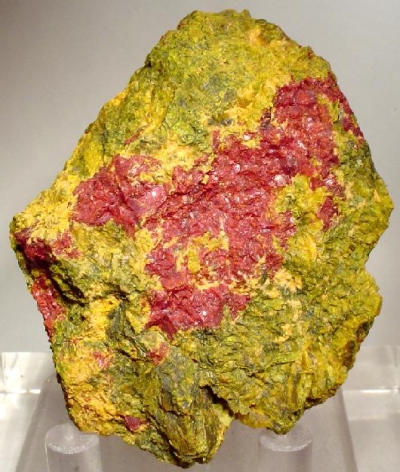
Orpiment is another arsenic sulfide mineral with a stunning orange-yellow color. The mineral is found naturally in hydrothermal vents, hot springs, and fumaroles. Strangely, this mineral was once used medicinally in China despite its toxicity and in alchemy in search for a way to create gold. The arsenic, especially if it is allowed to oxidize, will lead to arsenic poisoning if handled incorrectly.
Stibnite - Sb2S3
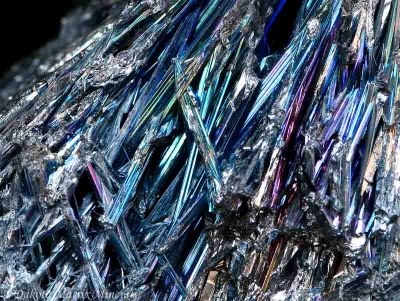
Stibnite is a toxic antimony sulfide mineral with an orthorhombic crystal lattice and a source of metalloid antimony. Stibnite paste has been used for thousands of years for cosmetics to darken eyebrows and lashes. The mineral was also used to make eating utensils, causing poisoning from antimony ingestion.
Torbernite - Cu(UO2)2(PO4)2 · 8 - 12 H2O
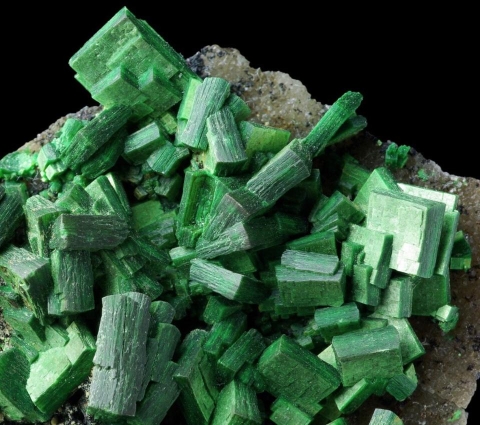
Torbernite is a dangerous mineral composed of hydrated green copper, phosphate, and uranyl and is dangerous due to its radioactive nature. The mineral releases radioactive radon gas naturally and can cause lung cancer if exposure is long enough. It should never be stored in an enclosed space.
Learn more about MINERALS and MINERAL IDENTIFICATION
source https://mineralseducationcoalition.org/minerals-database/arsenic/
https://www.forbes.com/sites/trevornace/2016/02/14/9-deadliest-rocks-and-minerals-on-earth/#4cc8c0da659b
https://en.wikipedia.org/wiki/Arsenic_poisoning
https://www.newyorker.com/magazine/2013/10/14/murder-by-poison
http://www.telegraph.co.uk/books/what-to-read/could-this-wallpaper-kill-you-victorian-britains-lethal-obsessio/
from the collection of Earth Science Australia

